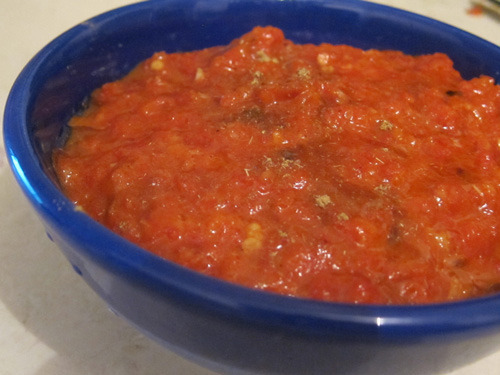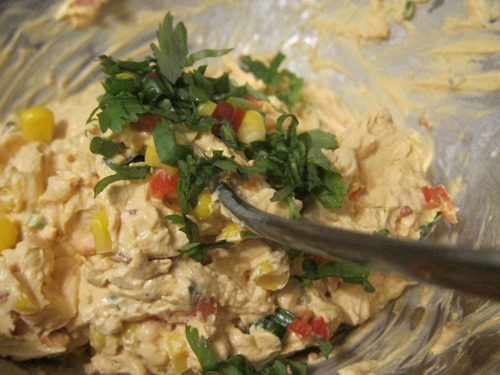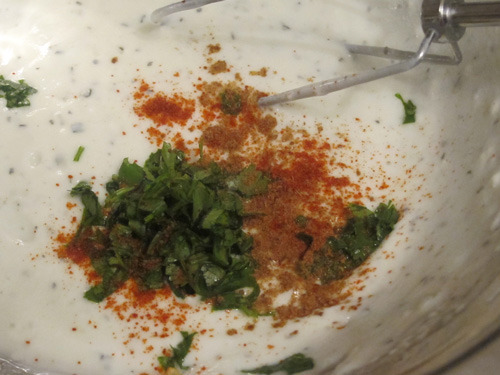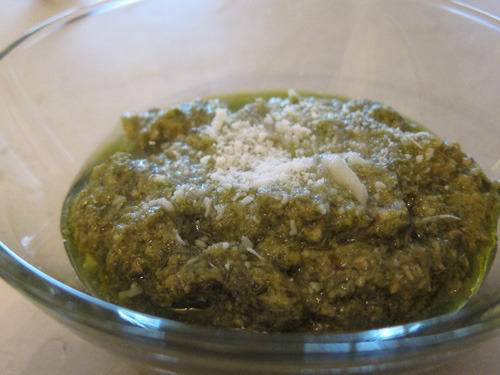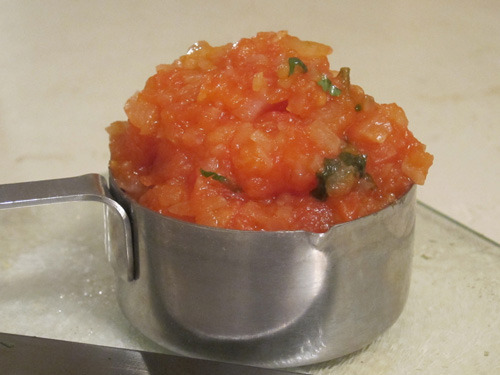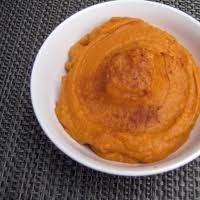Rachael Ray's Blog, page 99
April 4, 2012
The New Age of Hair Color
Cutler color specialist Chiala Marvici keeping us abreast with what's new and innovative in coloring. When it comes to the world of hair coloring technology has not evolved at the same rate as other industries, for example music, cassettes to CD's to the iPod. So, it's an understatement to say it's exciting and long overdue to see some fresh innovation in the hair coloring category and welcome the new age of hair color.
For decades we have relied on ammonia-based hair color which can take its toll on the hair. Now the shift is towards ammonia-free permanent hair color that utilizes oil in the formulation as a delivery system with the infusion of protein in the dyes. How this translates to you is richer and longer-lasting color that is more vibrant and is less likely to fade. Another incredible benefit is that the hair is fortified by the color process without any reduction of moisture. From a salon experience these dyes are odorless and reduce scalp irritation which is delightful for everyone. First to the dance has been L'Oreal and Redken but I'm sure there will be many more to follow as this technology is here to stay! Keep an eye out for the new age of hair color.
April 2, 2012
Easy to Make Homemade Household Cleaners!
When the bathroom gets really gross, or the kitchen is covered in greasy grime, it can be comforting to use a harsh chemical to get rid of the mess. We've been conditioned to think the more toxic the chemical, the better it will clean.
However, harsh chemicals can be bad for the air inside the home. Studies have shown links between stay-at-home moms and higher cancer rates due to inhalation of toxic chemicals (http://www.non-toxic.info/Health_Stat...). Also, dumping all those chemicals down the drain is terrible for the water supply. The toxic substances found in many household cleaners are not adequately removed by sewage treatment plants. Once the water leaves the plants, it is returned to the water supply.
All good reasons to ditch those chemicals, and start cleaning our homes like our grandmothers did. They really do work, and I promise your house will smell fresh and clean.
As with any cleaner, if something is precious to you, test a small spot before cleaning, so you don't ruin you favorite things.
One more thing. Go buy yourself a stack of bar rags, or cut up some old clothes or tablecloths, and get rid of those paper towels. There's really no need for them. A lot of natural resources goes into making those towels, and they don't work any better than a plain old rag. When the rag gets gross, just throw it in the wash with the rest of the laundry. Not only will you be saving trees, you'll be saving money too.
Four an all-purpose household cleaner, try one of these:
In a spray bottle add:
1 cup white vinegar
1 cup water
Just spray and wipe clean
For a more heavy duty cleaner:
2 tsp. Borax (found in the laundry detergent isle)
4 tbsp. white vinegar
1/4 tsp castile soap
3 cups hot water
Surface Cleaner:
1 1/2 cup baking soda
1/2 water
Mix in a jar to create a paste. Spread over the desired surface and clean with a sponge.
Disinfecting cutting boards
Rub a half lemon on the surface. For tough stains let the lemon juice sit for a while, or rub in a little salt.
Bathroom Mold Remover
1 part hydrogen peroxide
Two parts water
Spray on mold. Wait at least an hour before rinsing.
Laundry:
1 cup peroxide in the wash instead of bleach.
Fabric Softener: 1 cup vinegar to the laundry. Just add to rinse cycle, or in the fabric softener compartment.
Window Cleaners:
In a spray bottle add:
1 tbsp. lemon juice
2 cups water
Or 1/4 cup white vinegar
2 cups water
For an extra strength glass cleaner:
1 cup rubbing alcohol
1 cup water
1 tbsp ammonia (non-sudsing)
Wipe with a rag like you would for a store bought cleaner.
Floor cleaners
Vinyl and linoleum:
1 cup vinegar
A few drops baby oil
1 gallon warm water
Wood:
Equal parts water and vinegar plus 15 drops pure peppermint oil.
Wood floor polish:
1 part vegetable oil
1 part vinegar
Rub in well
Brick and stone:
1 cup vinegar
1 gallon water
After washing rinse with water
Carpet cleaners
Use equal parts vinegar and water. Spray on the stain and let sit several minutes. Clean with brush or sponge and soapy water.
For greasy spots:
Sprinkle corn starch onto grease. Wait 15-30 minutes. Then vacuum.
For tough stains:
1/4 cup salt
1/4 cup borax
1/4 cup vinegar
Rub paste into carpet and leave for a few hours. Then vacuum.
Furniture polish
1 cup olive oil
1/2 cup lemon juice
Shake well. Apply with a flannel rag. Spread evenly. Polish with a dry cloth.
Metal Polish
Aluminum: using a soft cloth, clean with a solution of cream of tartar and water.
Brass or bronze: polish with a soft cloth dipped in lemon and baking-soda solution, or vinegar and salt solution. Use a drop of ketchup on tarnished spots.
Chrome: polish with baby oil or vinegar.
Copper: soak a cotton rag in a pot of boiling water with 1 tablespoon salt and 1 cup white vinegar. Apply to copper while hot; let cool, then wipe clean. For tougher jobs, sprinkle baking soda or lemon juice on a soft cloth, then wipe. You could also apply a little ketchup on a soft cloth and rub over tarnished spots.
Silver: line a pan with aluminum foil. Add two tablespoons baking soda. Place silver in pan and fill with hot water. Let sit. For really tarnished pieces, buff with a cloth.
April 1, 2012
Easy Easter Dessert: Chewy Lemon Honey Cookies
There's something about Spring and especially Easter time that makes me want to incorporate lemon into everything I'm cooking. As the weather warms up, I find myself craving the light and refreshing taste of citrus. To me there's nothing more crisp and clean smelling than a freshly cut lemon. I could literally put it in and on anything and everything—and usually do!
The other day I was craving cookies but wanted to try something new and unexpected, so I decided to bake some using, you guessed it— LEMON! I knew I wanted a light cookie but one that was also sturdy enough to have a nice chew to it but I had never made a lemon cookie before so I went straight to one of may favorite chocolate cookie recipes and re-worked it to accommodate my lemony craving. Boy, oh boy, did this cookie turned out to be winner. They were gorgeous right out of the oven but as they cooled, the cookies flattened a bit and cracked slightly on the giving them a simple, rustic elegance. The lemon gives the cookies a bright flavor without being tart or overpowering and the addition of honey are what gives these cookies the perfect amount of chew. In fact, no that I think about it, the texture of these cookies are perfect to use for ice cream sandwiches and would be amazing slathered with some rich and creamy vanilla ice cream. Note to self: make another batch and try this ASAP!
My family loved these so much I've decided to make them again for Easter Day as an addition to our already overflowing dessert table and maybe I'll even sneak in a few ice cream sandwiches as an extra surprise. Why not, it's the holidays! : ) Happy Holiday, everyone!
Lemon Honey Cookies
Makes 20-24 cookies
Ingredients:
2 1/4 cups all-purpose flour
2 teaspoons baking soda
1/2 teaspoon salt
3/4 cups unsalted butter, melted and cooled
1 cup granulated sugar, plus 1/2 cup extra for rolling cookie dough in before baking
1 large egg
1/4 cup honey
1 teaspoon vanilla extract
Zest of 1 lemon
Juice of 1/2 lemon
Instructions:
1. Preheat oven to 350 degrees and line 2 baking sheets with parchment paper or a silpat liner.
2. In a large bowl whisk together flour, baking soda and salt. Set aside.
3. In a standing mixer set to medium speed, beat together butter, sugar and egg until smooth. Add in honey, vanilla extract, lemon juice and zest and beat until combined. Switch mixer to low speed and gradually add in flour. Continue to mix until just combined. Do not over mix. Cover mixer bowl in plastic wrap and chill in refrigerator for 1/2-1 hour.
4. Remove dough from refrigerator and roll it into walnut sized balls. Roll balls in remaining granulated sugar and place onto prepared baking sheets about 2 inches apart from each other. Bake for 8-10 minutes or until very lightly golden brown. Cookies will appear puffy and pale in color. Resist the urge to bake them longer. Remove cookies from the oven and allow to cool completely before removing from baking sheets with a thin spatula. Store in an airtight container on your counter for up to 5 days.
Christina Stanley-Salerno is a mama, recipe developer, food stylist, photographer and blogger atTakeBackYourTable.com. She loves cooking for and with her family. Life is hectic, but Christina is passionate about mealtime because she believes that family meals are the glue that holds everyone together. Creating simple, quick and healthy meals is her specialty and her trick to keeping the family meal a reality, even on busy weeknights.
Follow her on Twitter @TakeBackTables
At Last: My Much-Needed Overhaul For Scoring Cooking Contests
I get invited to judge food contests a lot. I have even done a couple of Burger Bashes (although for some reason I can't grasp I don't get invited back anymore.) But I've done lesser versions of the same event, and even competed in a few of them. Like competition barbecue, they are a noble idea undone by their judging system. I want to reform all cooking contests everywhere, and give you a good template for your own contest. And that's what I've done.
Most cooking contests use some variation of the following system: 2-9 points for taste, 2-9 points for tenderness, 2-9 points for originality, and 2-9 points for appearance. Can you believe how dumb this is? I'm going to bracket out the idiocy of separating taste from texture, since texture influences how you taste food in more ways than you can ever know. But, even setting that aside, taste is obviously far and away the most important thing you can look at when considering food. It is the work of a mindless moment to think of three or four categories and set them aside each other on the same scale. But these contests have been going on for years! And appearance scores continue to weigh equally with taste.
As for originality, don't even get me started. Originality is a completely neutral value when it comes to food, and the reason is obvious: people have been eating for a long time. Therefore most of the good things to eat have already been invented. Which means that most of the new things are bad. (In biology, this fact accounts for why so few mutations are passed along to future generations.) Moreover, the effect of novelty is so strong on the human mind that a truly original dish will generally seem a lot better than it is.
So when given the opportunity to create a new burger contest for Baldor Foods, I jumped at the chance. My criteria are as follows:
Enjoyability (1-10 points): How good is it, strictly in terms of flavor / texture / temperature? Because all three of these things are important, and it's asking too much of a person eating a dozen hamburgers to separate out sensations no human being would ordinarily be conscious of.
Edibility (1-5 points): How well-constructed is it? Does it fall apart? Are all the elements present in each bite? Is it a huge nasty mess, or a clean, compact, well-thought out dish?
I feel that this is the single most overlooked part of sandwich cooking, and cooks need to be penalized / rewarded for it far more than they currently are. Typically, a judge will take one bite of a burger, and will do the cook the favor of arranging the elements into that bite. Forget that! A big unwieldy mess that falls apart the second you look at it is a discrace and deserves to be a contest-killer.
Integrity (1-5 points): Is this burger good because it's a really well-made burger, or because it has other elements (foie gras, pastrami, etc.) that you like? A burger that was just beef on bread would get a 5; a huge dagwood that has a shrimp patty at its center would be a 1.
Again, this is something I don't think is looked at enough. The spirit of these events should be ignored at their own peril. In competition barbecue, the cooks frequently make ribs or chicken that are closer to pudding or stew than barbecue, but that's what the degenerates recruited to judge these events like. This category would put an end to this perversion of cookery.
Highest score is the winner; and judges are allowed to choose their favorite in event of a tie.
I'll be judging the Baldor Burger Battle of the Club Chefs (don't ask), but these criteria will fit any contest, from the White Castle Cook-Off to the Bocuse d'Or. If you see some kind of chili faceoff in your future - and you should, because they are super fun - I would urge you to give my system a try. I'm going to take a run at convincing the Burger Bash, but I doubt they will heed my advice. I'm a radical, a revoutionary, a rebel. But you have to give me points for originality.
March 30, 2012
The chicken and the egg
As I was strolling through the farmer's market the other day, I was admiring the araucana eggs, all light blue and fresh looking, but they cost a fortune! I bought them anyway to remind myself that they do in fact taste different, not only because of the breed, but also because they are organic and straight from the farm.
I decided to have hard boiled eggs the next day for breakfast so I could eat really the egg and nothing else. Someone with more courage may have even eaten them raw but I am no Rocky. The egg yolks were such a beautifully vibrant and yellow color, and they literally tasted like the earth and grass that those chickens must snack on while roaming free.
It got me thinking-I have these two guinea pigs as pets who, while cute and affectionate, are pretty useless. I actually feel bad for them because they are caged almost all the time. The cage is no normal cage, it is a 3′x5′ pen really, one that I have to bring myself to clean every week. I thought, if I can take care of guinea pigs, why can't I get my own young chickens and care for them, and this way, we also get eggs out of the deal and I don't have to spend a fortune at the farmer's market. Not only that, I will know exactly what those birds are eating and be able to literally take a freshly laid, still-warm egg and call it breakfast. Ah sigh, what a thought!
So I looked around and found these chicken coops you can order online-simple to install and not too expensive (the wooden ones I found were over $1K). They are from a British company called-are you ready-Omlet (ha ha). Apparently in Europe it isn't so crazy to have chickens as pets.Their website makes it all seem so easy. I mean just look at this happy mother with her children and her chickens! How natural and carefree! Plus, if you order the coop from this site, you can also order the chickens to come with them and they will be delivered to you!
So far my town is ignoring me since I called and emailed them to make sure we are allowed to keep livestock as pets. Apparently this is not acceptable everywhere and someone told me my town won't allow it, so being the good citizen, I am actually asking permission and waiting patiently…..
Does anyone else keep chickens? If so, any advice? Are they easy to care for? Is it worth it?
Rosemary Maggiore is our Last Minute Lady. A single mom of two kids plus a full time job (she runs this website!) keep her busy and usually pushing things to the last minute. Somehow she manages to keep her cool and her sanity while she enjoys good food, wine, friends and most importantly, family.
For more Ro, see:
Follow me on Twitter at @lastminutelady
Your week nights just got a whole lot saucier
They all do it. Presidents do it, your boss does it and now even your husband is doing it -or at least mine certainly is. Yes, you got it - Budget cuts! When that budget cut conversation invades the intimacy of my home, it leaves me exposed and scrutinized. Do I really need to explain the necessity behind that stunning scarlet scarf that would pick me up on duller days? Anyway, last week, that quarterly conversation surfaced again and for at least the next 2 weeks, I need to be on my best behavior or do a better job of covering my tracks.
One of my biggest challenges is 'organization' which ultimately leads to unaccountable money wastage. Figuring out what we are having for dinner 30 minutes prior to dinner time hardly sets me up for success and then leaves me in the hands of delivery menus. This week I am giving 'a complete week of home cooking' a shot. It will be very manageable as I have already done my homework and I will provide variety, freshness and internationality to my family. I will be making simple sauces that will change up my dishes from night to night. How about steak spread with a Moroccan sauce of harissa or simple vegetable soup finished with homemade pesto? This week, I am aligning the goals of my stomach to my wallet. I pulled sauce inspirations from the following 5 countries to get my week night meals organized:
1) Mexican chipotle pepper sauce - This is my sister-in-law 'Mamtas' recipe. Don't be fooled by its creamy appearance as this sauce bites right back thanks to its friend 'chipotle'. It's a perfect sauce to finish sautéed chicken in or simply add a dollop to a baked potato.
2) Morocco's Harissa - This North African spicy and smoky sauce adds depth to any dish. Give your roast chicken a final baste of it or spread a layer on a toasted sandwich, this sauce will add sensuality and a promise of mystery to any dish
3) Italy's Pesto - No weekday meal would be complete without a nod from Nonna. Of course, just a dollop to plain pasta will complete your dish, but how about changing it up by adding to a salad or soup
4) India's Mint yoghurt chutney - The combination of yoghurt and mint makes this both a great dipping sauce and a marinade. In India, people use yoghurt in meat dishes be it a curry or a dry-cooked grilled dish due to its acidic qualities that tenderize the meat. The yoghurt also gives the dish a sharp and tangy flavor
5) France's Tomato Fondue - Similar to a tomato relish, this tangy and sweet sauce can be used as many ways as the imagination can stretch. With flavors of Southern France add to ground meat or layer within a vegetable bake. Be sure to keep aside some for your Sunday brunch omelet filling.
5 night sauce recipes
Harissa
4 garlic cloves, peeled
5 Dried Chiles
½ teaspoon salt
3 tablespoons olive oil
3 red bell pepper, roasted, peeled and deseeded
1 ½ teaspoons cumin
1 tbsp. Caraway seeds
1 ½ teaspoons coriander
pinch cinnamon
pinch ground nutmeg
Lemon zest and juice (Optional)
¼ cup of oilve oil
1) Toast chilies in a dry skillet, transfer to a bowl, rehydrate by covering with very hot water.
2) When peppers are soft, drain and chop them.
3) In a food processor, mince the garlic. Add the roughly chopped chilies and salt and continue to process.
4) Roughly chop the bell pepper and add to the food processor. Stream in olive oil steadily
5) Add the spices, lemon zest, and juice,
Chipotle pepper sauce
1 x 8oz packet of cream cheese
1 small can of chipotle pepper in adobo sauce (you will need only one pepper and can freeze the rest)
Scallions, 4 sprigs, finely chopped
¼ cup of sweet corn
Cilantro, handful, finely chopped
Salt to taste
2 tbsp of fresh squeezed lemon
1) Combine the cream cheese, chipotle pepper, salt and lemon juice in a food processor
2) Add the sweet corn, scallions and cilantro
Mint Chutney & Marinade
1 cup yoghurt
2 tsp. mint sauce
¼ cup fresh cilantro
½ tsp cumin
¼ tsp cayenne pepper
Salt to taste
1) Whisk all the ingredients together
Pesto
1 large bunch of basil, leaves only, washed and dried
3 medium cloves of garlic
One small handful of toasted pine nuts
salt
3/4 cup Parmesan, FRESHLY GRATED
¼ cup of extra-virgin olive oil
Juice of 1 lemon and zest
1) Combine basil leaves, garlic, salt, lemon juice and nuts and pulse in a food processor until coarsely chopped
2) Stream in the olive oil, once smooth, combine pesto with grated parmesan and lemon zest
Tomato fondue
3 tomatoes, blanced, de-skinned and deseeded
2 shallots, finely diced
Parsely stems
Thyme
Bay leaf
Garlic
Salt
Pepper
1 tbsp. fresh minced parsley
Olive oil
1) Sweat the shallots until soft. Add the garlic, thyme, bay leaf and parsley stems. Sweat for a couple of minutes
2) Dice the tomatoes and add to the shallots. Season with salt and pepper
3) Cook on medium heat until it has a smooth consistency and the moisture has evaporated. Add the freshly minced parsley
Saira Malhotra is a classically trained French chef and graduate from the French Culinary Institute. A British born Punjabi, Saira has grown up around food with her family pizza business where she helped spreading tomato sauce and smuggling cheese for her own little stash. Having studied in France and Italy and living in the Big Apple for the past 12 years, Saira has brought her European, Asian and American influences together via the palate and communicated through her food blog: www.passportpantry.com
March 28, 2012
March Madness
March Madness is a national phenomenon. Sports fans of all ages join in. It has everything: buzzer beaters; Cinderella stories; heartbreaking last second losses and hysterically happy upset wins. There are triple overtime games that end with young players sobbing on the bench into their towels, while the victors are sobbing in joy on the floor. David can triumph over Goliath. The highs and lows are intense because the players are all such young men and women. The drama is constant and the pain and joy are almost inseparable stories.
I know that I personally may never fully recover from the Final Four of 1989. My brother P.J. Carlesimo was coaching Seton Hall. In the first game of the Final Four, the Hall came back from 20 down to beat Duke by 17, everyone's pick to win it all. We tied Michigan in the Championship game with a three point shot to go into overtime, and then lost in overtime on a foul shot in the last seconds. It was a bitter ending to a Cinderella story for a wonderful group of young men, and of course a great coach. I had decided to leave my two year old twin daughters at the last moment to go out to Seattle, and consequently had one of those four stop plane tickets back to New York. Remember the song Cry Me A River? Well, I must have cried an ocean as I zigzagged back home across the country!
And all of this drama is coupled with the fans' obsession with their brackets! The country is alive with the talk of brackets and the new science of Bracketology. Everyone from the President to your neighbor, son, and daughter filled one out. This year, there were almost 7 million registered at ESPN alone. And what do you have to do while these four weeks of March Madness go on? You have to EAT during the games, of course! And I am here to tell you about some foods to help you through.
Little Miss Muffet Sat on a tuffet
Eating her curds and whey,
Nursery Rhyme.
In Chicago, recently, I ate in a new restaurant that specializes in Midwestern artisan beers and food called the Farmhouse Tavern. Chef Eric Mansavage is a truly talented young chef. But to return to March Madness, he makes a heavenly concoction called Wisconsin Cheese Curds that would be perfect for watching basketball games with a glass of good beer. Apparently invented in Wisconsin, I can't believe they taste this good anywhere else. Curds are one of the early stages of cheddar cheese and best consumed when just made. Chef Eric dips them in an indescribably delicious secret batter, deep fries them, and serves them with Alder Smoked Catsup. They are little yellow and white balls of cheese bliss. I am working on Chef Eric to see if we can get the recipe.
Cloudy with a Chance of Meatballs
Judi Barrett
Is there anything better than meatballs? But how can you eat them while watching basketball games on TV? Our good friend George Duran, who you may know as host of Ham on the Street on the Food Network, has a great solution for this March Madness problem. This is the perfect pick it up and be able to eat it with your hands food. He starts with a delicious recipe for Meatballs. Then he adds the perfect pasta. It's getting even better but how does this work as finger food? George puts the Meatball on a stick and uses a pasta that you can wrap around the meatball, or put right under it on the stick like a bow-tie. Then George sets a bowl of delicious marinara sauce next to the meatball sticks for dipping. Now does that sound good? His cookbook, Take This Dish and Twist It, is actually full of inventive, easy fun dishes for entertaining.
MEATBALLS WITH PASTA ON A STICK
photo Blaine Moats and Scott Little
Ingredients:
1 (35-ounce) can crushed tomatoes
3 sprigs fresh thyme
1 bay leaf
1 tablespoon dried oregano, crushed
2 teaspoons garlic powder
1/8 teaspoon sugar
Kosher salt or table salt and freshly ground black pepper, to taste
1 pound ground beef
1 pound ground pork
½ bunch fresh parsley, snipped
1 cup dry bread crumbs
1 tablespoon ground cumin
1 tablespoon dried oregano, crushed
2 eggs
6 ounces dried farfalle, large rotini and/or mafalda pasta
2 tablespoons extra virgin olive oil
1 unripened melon
80 wooden skewers
Preparation:
For the marinara sauce, in a saucepan over medium heat combine the tomatoes, thyme, bay leaf, oregano, garlic powder, sugar, salt and pepper. Simmer for 10 to 15 minutes. Or you can use your favorite bottled sauce!
Preheat the broiler. In a large bowl mix the beef and pork; add the parsley, bread crumbs, cumin, oregano, and eggs; season with salt and pepper. Mix well to combine. Roll 1 tablespoon of the mixture into a small ball; repeat to make about 80 small meatballs. Put them on a baking sheet; broil about 10-15 minutes or until they are browned and cooked through.
Cook the farfalle according to package directions. Drain and rinse in cold water. Toss with the oil.
On each skewer thread a farfalle and a meatball. To serve, cut an unripened melon in half lengthwise and put it cut side down on a platter. Insert the skewer into the melon. Serve with warm marinara sauce for dipping.
© Pop Cuisine Publishing, Take This Dish and Twist It (Meredith Books, 2008)
This recipe and many other family favorites are available on DishandDine.com. Stop by and become part of this grass roots global food community!
DishandDine - It's All About Food
http://www.facebook.com/DishandDine
http://www.twitter.com/DishandDine
.
The Blue Bag and the Afterburner Method: Keys to Grilling
This was the warmest March on record, and while that portends evil for the earth, it's nothing but great when it comes to grilling. I was able to burn my first coals of spring on my roof this past weekend. They were the same, classic "blue bag" Kingsford coals that we all grew up using; the C-Town supermarket across the street from me doesn't carry anything else, and in fact, nothing else is really necessary.
A note on charcoal: I know I always say that you should, if at all possible, use lump hardwood, for reasons of both physics and flavor. The lump hardwood does burn hotter, and taste better, than blue bag charcoal, but it also burns out much faster and its irregularities - one spot hotter than the surface of the sun, the other barely getting any radiant heat at all - can drive even the most patient of cooks crazy. My even bed of black, identically-shaped briquettes allowed me to four or five different pieces without refueling, and to have total control of the heat in my weber. And for that super-intense heat, I use my friend Craig "Meathead" Goldwyn's "afterburner" technique.
Basically, this consists of taking the starter chimney, and putting a grill on top of it. The starter chimney is a simple cylinder of metal with a hand on the side: you put coals in it, stick newspaper underneath, and 15 minutes later you have the makings of a hot coal fire. No one but Meathead, to my knowledge, has ever used it to actually cook, possibly because the heat that emerges from the top of it is so blazingly hot. With its bluish flame and round shape, it looks something like the afterburner of a jet - hence the name. By cooking directly on the chimney, you can get an almost-instantaneous sear on thin pieces that can't sit too long over regular briquettes, even when banked up for maximum effect. It's a great innovation, and one Meathead deserves much credit for.
There's just one problem with it: you're limited to the size of the chimney. I wanted to do some thin steaks I bought at C-Town, but they were too long to get the full heat. Like a strip of bacon in a round pan, only the middle really got the heat. So I solved the problem by the most obvious expedient: cutting the steak in half. The think steaks were just the appetizer, anyway; I had marinated some chicken in lemon and olive oil and garlic and whatever spices I had lying around, and cooked it as the main course, along with some pieces of slab bacon and some radicchio. (Danit loves radicchio, don't ask me why.)
The Kingsford coals tasted great, and told me at a stroke that the weather had changed and that the long, weak winter was over, and that I could proceed to exert myself on behalf of the cause of grilled meat yet again. Full disclosure: I recently visited the Kingsford HQ, and am hoping to get them onboard for the big win at Meatopia. But beween the chicken wings, the steaks, and the recipes those guys have developed for out-there non-meat dishes like grilled salsa and grilled lemonade, I was re-inspired to start cooking with traditional charcoal again. And this week I'm going to do it again.
March 25, 2012
Homemade Baby Food Tools And Tips. Plus, a Recipe for Roasted Cinnamon Sweet Potato White Bean Mash
I have been obsessed with making my own baby food since my first son was born over three years ago. Confession: I think my obsession with it actually started when I was a little girl and I saw the movie Baby Boom. Whatever. I won't go into all of the reasons why I feel that making your own baby food rocks because, if it ain't for you, it ain't for you. I know plenty of folks who have no interest in making food for their babes when they can just as easily buy it in the store. And that's OK. Right on! Do you. Parenting is all about doing what works for you and your lifestyle. These days there are some really great organic pre-packaged baby foods on the market which is wonderful. However, making your own baby food really is super healthy, simpler than most people think and A LOT less expensive. So, if you want to give it a try, this post's for you.
I've been on both ends of the mommy-hood spectrum— full-time working mom outside of the home (with my first son) and work-at-home mom (after my second son) and with both lifestyles, it's been possible for me to manage making my own baby food. It really is totally doable and not at all overwhelming. It doesn't have to be stressful and you don't need loads of fancy equipment. Keep it simple, do a little research and most importantly, have fun!
{READ UP}
Research baby food making techniques and recipes. While baby food making is simple, especially if you already know how to cook, it does require proper technique. It's best to familiarize yourself with the process so you can be sure you are making the food in proper way as to maximize flavor and nutrition and minimize any chance of contamination. After all, we are feeding tiny humans, here. There are some amazing books and websites out there to guide you in the right direction. Once you get the gist of the basic techniques, you are free to go wild. Play around with flavors and textures with each stage of your babies development. This is supposed to be fun, and it is!!! Hands down, my favorite resource for all things baby food is WholesomeBabyFood.com— one of the webs top rated sites. It's really a one stop shop in the sense that not only are you getting recipes, you're also getting information on allergies and some great tips on introducing solids. From infant to toddler, you cannot get a better resource for everything baby food and it's all just a click away.
{TOOLS}
You really don't need uni-tasking fancy-schmancy baby food making devices to get your baby food-on. For reals. I think some of those appliances are ridiculous and such a waste of money when all you really need are a few pieces of equipment that you probably already own thanks to your bridal shower. And guess what? now you finally have an excuse to use them. Hooray!
Food Processor or Blender: I used a mini version of this bad boy to make all of my first sons food. it was so much easier than whipping out my bigger heavier version and it worked like charm for small batches. A bigger one definitely comes in handy for larger batches but, if you are short on cash and counter-space, this puppy can be had for around $29 bucks. Plus, when the baby has outgrown purees, you have a food processor that you can use for a million other culinary adventures. You're welcome! You can also use a blender but most blenders, in my opinion are pretty lousy at this sort of thing unless you have the mother of all blenders—The Vitamix! it's a freaking fortune and I'm not ashamed to say I have one (thanks mom!) because it literally has replaced at least three appliances in my kitchen and I use it every. single. day. This is not meant to be a Vitamix commercial but, it f you feel like dropping some dough, you will not be disappointed.
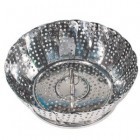
Steamer Basket: I bet you already have one of these buried in the back of one of your cabinets and rarely if ever use it. I bet some of you don't even know what it is used for, amiright? Psssst…it's a steamer and it rules! It's cheap (about $5 smackaroos), easy to clean and adjusts to fit inside most pots. Use it to steam up any of your fave fruit, veggies or even protein in a flash!
{STORAGE}
One Ounce Storage: I've literally tried every single baby food storage item on the market and there are only two I feel are worth buying. When you first start out, your baby will only be eating tiny amounts of food at a time so it is best to store it in once ounce portions. The best way I have found to do this is buy using a BPA free covered ice try like the ones Fresh Baby makes. Note: I only felt I needed two trays because I would make a batch of food, freeze it, pop them out into a freezer storage bag and wash the trays for the next use. The small quantity stage goes by so fast so don't go nuts buying too many 1 ounce portion storage containers. You won't need them.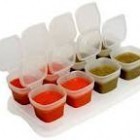
Two Ounce Storage And Beyond: As your baby begins to grow and eat larger portions, it's good to invest in some two-four ounce storage containers. After three years and two kids, my fave are still Baby Cubes. Besides being BPA , Phthalates free (muy importante!!) and freezer and dishwasher safe. And possibly my most favorite feature is the permanently attached lids—no messing about looking for lost liddage in a sea of sippy cups. Hooray!
{RECIPE}
Busy parents are always looking for ways to save time and money and this recipe does both. This is a recipe that I can make for guests and also serve to my 10 month old. The combination of white beans and roasted sweet potatoes makes for an excellent dip for a party and an amazing meal for your little one. The beans give this puree a nice creamy texture and they add an inexpensive protein punch to baby's meal. A protein boost from beans means it's also perfect for the vegetarians in your family.
Sweet potatoes are often a favorite first food for baby and adding the mild tasting white beans enhances the nutrients without changing the taste. Perfect for even the pickiest eaters. People of all ages will love this as a side or even served chilled as a dip with some toasted pita chips.
Roasted Cinnamon Sweet Potato White Bean Mash
Ingredients:
3 large organic sweet potatoes, peeled and cut into 1-inch chunks
1 ½ teaspoons, extra virgin olive oil
1 tsp organic cinnamon
1 can organic white beans, rinsed and drained (I like to use Canellini beans but navy or butter work well too)
water, if necessary to adjust consistency
Instructions:
1. Preheat oven to 350 degrees. Line a rimmed baking sheet with aluminum foil.
2. Toss potatoes with olive oil and bake for 30-40 minutes, tossing with a spatula halfway through to encourage even browning. Potatoes should be fork tender when they are ready.
3. Allow potatoes and onions to cool slightly before tossing into a food processor along with beans, cinnamon, salt, pepper and water (if needed). Puree until desired consistency is reached. Serve chilled or warm as a baby puree or with pita chips as an awesome party dip.
Enjoy!
TIP: Swap the sweet potato for butternut squash.
TIP: Roast 1 clove of garlic alongside the potatoes and onions for an extra layer of flavor.
Found! America's Greatest Meatery
Chris Phelps of Salt's Cure
I eat a lot of meat. You know that. It's what I like to eat, and it's what I cook. If you want healthy foods or vegetables, you need Luisa. If you want great home cooking tips, go to the Last Minute Lady. I'm your meat guy. But my cooking column is, as a result, laughably simple-minded, since the art of cooking meat is necessarily simplistic. You have to get the best meat, and do the least to it: it's really as simple as that.
I bring this up because I just ate at what I think is the best meat restaurant in America yesterday. I don't say this lightly. I risk offending a number of chefs whom I admire greatly and even whom I think of as friends: they would include, say, Riad Nasr and Lee Hanson, Sean Brock, April Bloomfield, Naomi Pomeroy, Michael White, and Seamus Mullen, among others. The chefs at Salt's Cure, the tiny LA meatery that so moved me, are by no means out-cooking those guys. But they are getting better meat: the best meat, in fact, that I have eaten in America. And they are not screwing it up. Salt. A little acid. They don't even have a wood grill, which is sort of a tragedy: all their chops seem to have been made on a gas grill, of the kind you might see in a mid-range mall seafood house. But this is supreme act of cooking skill, as I so often point out. Both men have plenty of experience. They have had their fun with uni and yuzu and they know all about the magic of the Almighty Boiling Bag. But they, commendably, dispensed with all that crap to instead focus on getting some of the best meat raised in America and cooking it with minimal interference.
Don't even get me started on the veal chop. Usually veal is something you eat entirely for its cleanliness, its sashimi-like qualities; here was deep pink beefsteak, from animals that were no longer infants. "They walk around with their moms," co-chef Chris Phelps told me, "instead of being suspended in a cage or whatever." Usually you lose the characteristic tenderness that you associate with great veal: as Joe Pesci tells his floozy in Casino "you get that pink veal, you can pound that shit all day and it won't be tender." But this veal, which comes from a ranch in northern California that is also the source of their wonderful African Boer goats, is unspeakably tender, lie the best milk-fed veal, but with the oomph and power and flavor of a steak. I didn't get to eat their steak, by the way - and I would be surprised if it were as good as Minetta Tavern's. But I need to try it either way. The pork was a true revelation - a hybrid between tamworth and european wild boars.
Ah, what pork! Eating it was an enlightenment. My senses and standards had become dulled; I was blind and unconscious, floating in my Matrix goo-pod. THIS was what pork was supposed to taste like! It's not like I suffer from a heritage pork deficiency. But the wild taste The mangalitsa bacon I had at Meatopia; the fire-roasted Red Wattle chop at the Vinegar Hill House, as piquant as a cherry pepper; the whole bellota fresca pig that Jose Andreas cooked in Aspen the night the Celtics lost game 7 to the Lakers for no reason. They're all great, but this was something else entirely. It tastes like a wild animal; even the boar you get these days doesn't taste like that. (For good reason: almost all commercially available boar is domesticated.) My only regret was that the meats at Salt's Cure are all cooked over a gas grill. If ever there was a restaurant that deserved a wood-burning oven, this was it. A sizzle plate and some post oak would put this place over the top. The goat was a wilder, more herbaceous cousin of lamb - but not with the same strangeness and tang that I had found in the other meats.
I could go on and on — the rillettes, the bacon, the hamburger — but I won't I am just going to sit back and feel the love for a place cooking meat the right way. I sent my own meat guru, Adam Perry Lang, there. That's how how strongly I feel about what these guys, and their farmers, are doing.
Rachael Ray's Blog
- Rachael Ray's profile
- 296 followers










